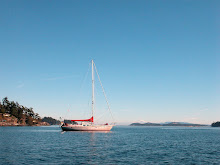It's difficult to leave places we love even when the destination is Greenland, one of the most spectacular sailing destinations we have ever been to. Finally at 5.30pm after lingering in town to enjoy the beautiful, clear Saturday afternoon. We said goodbye to Isafjordur and began making our way out of the fjord.
Tacking would have been too time consuming and we choose instead to motor into the headwinds, thinking we would sail once we reached open water. To our dismay, the wind funneling down the fjord was a local condition and the wind promptly disappeared as we exited the fjord. With flat seas, we found ourselves motoring for the first few hours of our 368 mile crossing to Tasiilaq, otherwise still known by its Danish name, Ammassalik.
On Sunday, 63 miles off the coast of Iceland, Krystina spotted the first iceberg. She had just tweeted "287 miles to go, calm seas, good wind and no ice," when she realized the cruise ship not running AIS was actually a sizeable iceberg. Not massive by Greenland standards but large enough to cause serious damage if a ship hit it at speed. Though we didn't have to adjust our course to avoid the iceberg, it was a reminder of why we needed to keep a vigilant ice watch.
The only real stress factor was fog, which always seems to roll in at the most inopportune time. Shortly after we spotted our first iceberg, we could see fog closing in around us. With visibility severely limited, we needed to rely on radar to pick up navigational hazards, knowing that large chunks of ice could still sneak up on us undetected. During the 11 hours of thick fog, the person on watch stayed close to the controls ready to take evasive action if an iceberg suddenly appeared in front of us.
On Monday morning, the fog lifted when the wind filled in from the north, revealing bright blue sky and sun. We were lucky that there was very little ice to be concerned about while we were sailing in fog. Our radar picked up two icebergs that could not be seen visually, the closest being 1 ½ miles to the south. In the afternoon, Frances spotted a submerged piece about the size of our dinghy bobbing in front of us, directly in line with the sun. She altered course and the large chunk of ice continued on its way undisturbed.
We braced ourselves for the fog to return in the evening but it never arrived. With the sun streaming into the pilothouse Frances found it difficult to want to come off watch and get some much needed sleep. Krystina understood the problem after the drop in temperature to 2.5C during the fog; there was something magical about having the clarity of the blue sky, the warmth of the sun and the dramatic outline of the Greenlandic mountains that came into view from 80 miles offshore. It was just too beautiful to sleep.
The wind was slowly beginning to die by the time Krystina came on watch at 9pm. She let Snow Dragon slowly drift under 3 knots as long as she could, not wanting to disturb the tranquil setting. Fulmars and skewers were peacefully floating around Snow Dragon in the calm water, which was alive with color from the setting sun, the mountains glowing orange in the distance. Just after midnight the speed dropped below 2 knots and Angela, the autopilot didn't have enough steerageway to maintain course. Krystina reluctantly started the engine and Angela moved Snow Dragon back on track in the gently rolling sea.
A few hours later we where adjusting our course to avoid a large area of drift ice. Krystina resisted the urge to take Snow Dragon into the broken sea ice for fun but eventually gave in and took a little detour so we could hear the ice moving against the water and sliding down Snow Dragon's hull. A sound we greatly missed during out time in the Mediterranean.
As we left the drift ice, we caught sight of a sailboat behind us. The wind had started to pick up and for fun we decided to focus on tweaking sails so we wouldn't embarrass ourselves by being overtaken. After a few hours of sailing along at 7 knots the wind died and once again we were under power.
By this time we realized the boat behind us was Imrama, a French boat that had left Isafjordur shortly before us. They appeared to be slowing down to look at something when we noticed the distinct fin of a male orca as it dived in the distance. Krystina had the camera ready with a telephoto lens but was so surprised when the Orca stuck its head out of the water right beside the cockpit that she missed the perfect shot of the whale starring up at her before it disappeared under water. Our passage to Greenland was turning into one the most memorable and pleasant crossing we've done.
Posted by satellite email, photos will be added when we next have internet access.
Tuesday, August 6, 2013
Subscribe to:
Post Comments (Atom)

Sounds beautiful, if cold!
ReplyDelete